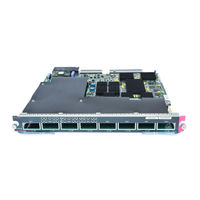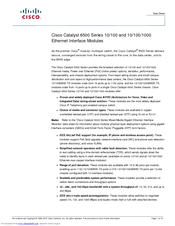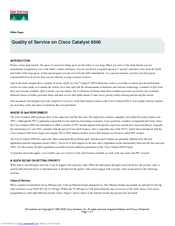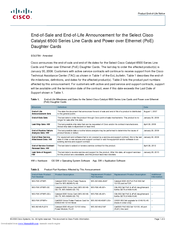Cisco WS-X6148-RJ21V= Manuals
Manuals and User Guides for Cisco WS-X6148-RJ21V=. We have 4 Cisco WS-X6148-RJ21V= manuals available for free PDF download: Software Manual, Datasheet, White Paper, Notice
Cisco WS-X6148-RJ21V= Software Manual (880 pages)
Catalyst 6000 Series Software Configuration Guide
Table of Contents
-
Audience27
-
Organization27
-
Preface
27 -
-
Task
71 -
Step 1
71 -
Command
71 -
-
-
-
-
-
Blocking State119
-
Listening State119
-
Learning State120
-
Forwarding State122
-
-
-
Disabled State123
-
MISTP Mode124
-
PVST+ Mode124
-
MISTP-PVST+ Mode125
-
-
-
Using PVST127
-
-
-
Configuring VTP
171-
Configuring VTP175
-
-
Deleting a VLAN195
-
-
-
-
Configuring MLS262
-
-
Configuring NDE289
-
Usage Guidelines290
-
Enabling NDE292
-
Disabling NDE295
-
-
-
Supported Acls298
-
Qos Acls298
-
Cisco IOS Acls299
-
Vacls299
-
-
-
Bridged Packets303
-
Routed Packets303
-
-
-
-
Configuring GVRP356
-
-
-
Using Telnet382
-
Using Ping385
-
-
Power Management401
-
-
-
-
MSFC Redundancy492
-
-
-
-
-
-
-
Configuring CDP
595 -
-
Configuring UDLD603
-
-
Configuring NTP608
-
Disabling NTP614
-
-
-
SNMP Terminology639
-
-
SNMP Entity645
-
Applications647
-
-
-
-
-
SPAN Session658
-
Destination Port658
-
Source Port658
-
Ingress SPAN659
-
Egress SPAN659
-
Vspan659
-
SPAN Traffic660
-
-
Configuring SPAN661
-
-
-
-
Configuring GMRP692
-
Configuring RGMP702
-
-
-
Definitions708
-
Flowcharts709
-
-
Configuring Qos736
-
Enabling Qos737
-
Disabling Qos766
-
-
-
-
Configuring ASLB787
-
-
-
Access Gateways820
-
I N D E X
849
Advertisement
Cisco WS-X6148-RJ21V= Datasheet (18 pages)
Catalyst 6500 Series 10/100 and 10/100/1000 Ethernet Interface Modules
Table of Contents
Cisco WS-X6148-RJ21V= White Paper (18 pages)
Cisco Catalyst X6524: Supplementary Guide
Advertisement
Cisco WS-X6148-RJ21V= Notice (4 pages)
End-of-Sale and End-of-Life Announcement for the Select Cisco Catalyst 6500 Series Line Cards and Power over Ethernet (PoE) Daughter Cards



